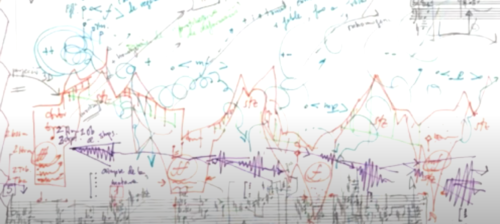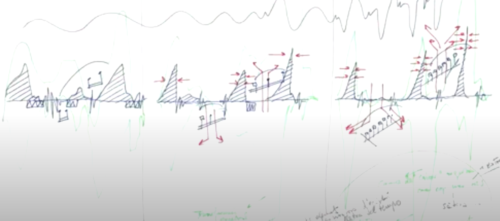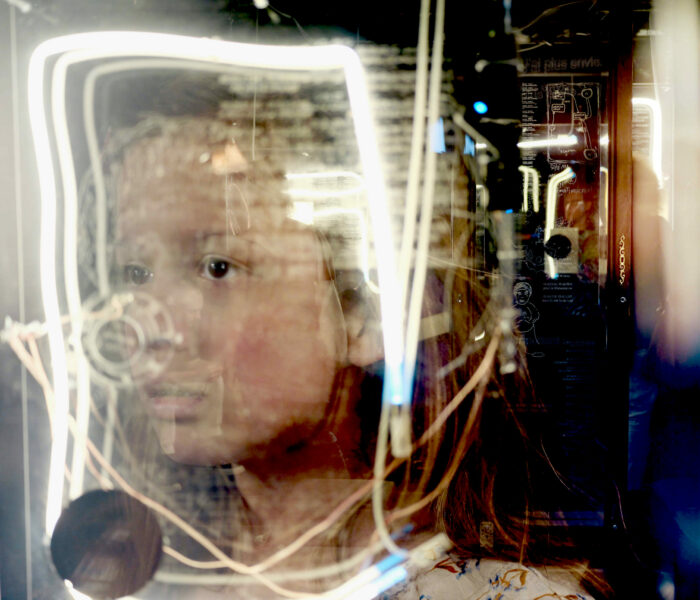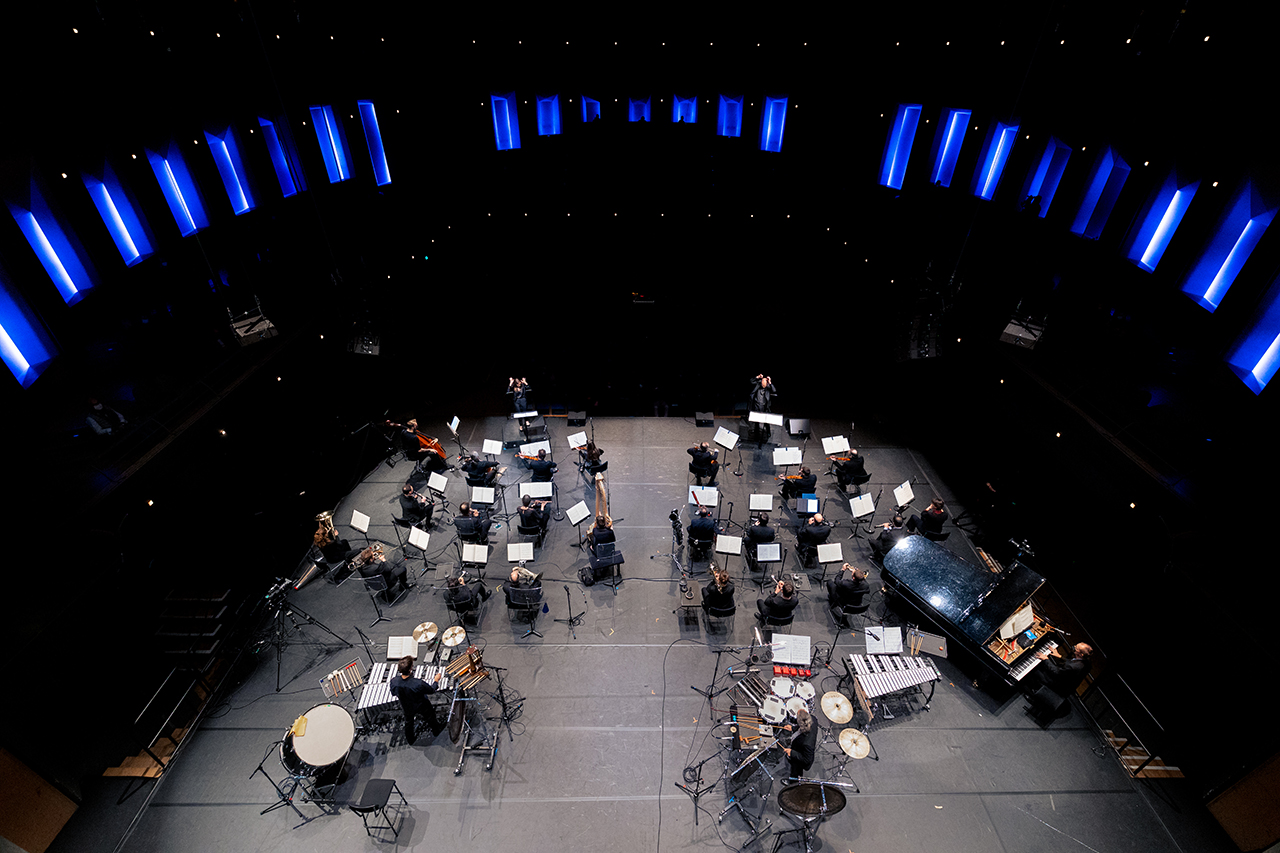Hector Parra est un artiste polyvalent, compositeur, dessinateur et interprète mais aussi un amoureux de la nature et du mystère de ses surgissements : un champ de connaissances qu’il ne cesse d’élargir et qui l’amène à élaborer des projets visionnaires en collaboration avec les spécialistes de la galaxie.
Depuis quand te passionnes-tu pour le cosmos et l’astrophysique ?
J’ai un père physicien qui m’a très tôt éveillé aux phénomènes naturels et qui m’a transmis l’amour de la nature. Dans mon enfance, j’ai beaucoup dessiné, représenté les choses jusqu’à ce que la musique prenne le dessus. Cette passion pour l’espace dans lequel nous évoluons, ce mystère de la vie qui m’interroge, nourrissent aujourd’hui mon imaginaire sonore. En 2005, j’ai commencé à lire des ouvrages de vulgarisation en vue d’un projet d’opéra avec la grande Lisa Randall. Je voulais avoir des données concrètes sur la physique des particules et la force de gravitation qui peut révéler d’autres dimensions de l’univers. Nous avons fait le livret ensemble, prenant exemple sur la démarche scientifique du chercheur qui gravit peu à peu les étapes de la connaissance. Hypermusic Prologue, mon opéra de chambre, créé avec les forces de l’Intercontemporain et de l’Ircam au Centre Pompidou, est le rêve d’une utopie qui invite le public à faire une expérience acoustique nouvelle et inattendue ; en quittant le monde en trois dimensions de la salle de spectacle pour accéder à celui d’une cinquième dimension où les sons comme les voix se transforment. J’ai essayé d’imaginer ce que pourrait être une voix de la « cinquième dimension » : très rapide, comme le bourdonnement d’un insecte ; j’ai essayé de créer un espace multidimensionnel avec l’appareil phonatoire. La recherche sur le langage vocal m’a beaucoup inspiré pour l’écriture instrumentale. Donné à sa création à Paris mise en espace par l’artiste plasticien anglo-américain Matthew Ritchie, l’opéra a été repris à Berlin et à Bâle en 2013, avec une mise en scène de Benjamin Schad. Ce fut pour moi une très belle aventure…
Qui va se poursuivre avec d’autres projets et un nouveau collaborateur, astrophysicien toujours, Jean-Pierre Luminet. Dans quelles circonstances le rencontres-tu ?
C’est à l’occasion d’une nouvelle commande de l’Ensemble Intercontemporain, Caressant l’horizon, une pièce pour grand ensemble créée à la Cité de la Musique en 2011, qui s’inspire de son livre sur les trous noirs, Le destin de l’univers. L’EIC m’a proposé de faire un entretien avec lui pour la présentation de la pièce. Nous avons depuis lors lié amitié et collaboré sur d’autres projets.



J’ai d’emblée été séduite par ce titre d’une sensualité qui peut surprendre, s’agissant d’un sujet aussi terrifiant !
Je ne suis pas un cérébral. Je vis dans mon propre corps les ondes gravitationnelles que je traduis dans mon langage sonore. J’ai travaillé sur des modèles d’ondes proposés par les chercheurs car on n’avait pas encore de certitude à ce sujet. J’ai imaginé l’activité de ce puits gravitationnel, évalué intuitivement la déformation des matériaux lors de la chute dans le trou noir et exprimé tout cela, très précisément, à travers ma notation musicale ; inspiré et aidé par les deux volumes de Luminet, dont je veux souligner la dimension pédagogique extraordinaire. Dans Caressant l’horizon, comme dans toutes mes compositions, je combine perception et architecture. La pièce dans son ensemble suit peu ou prou la trajectoire d’une forme sonate, avec exposition, développement et retour final à la vie sur terre, avec une certaine fragilité qui caractérise notre situation d’être humain face à ces phénomènes qui nous dépassent.
Venons-en aux deux collaborations avec Jean-Pierre Luminet, un scientifique, chercheur, qui est aussi graphiste, poète et musicien.
C’est un artiste complet, un véritable homme de la Renaissance ! En 2016, il m’a invité trois jours à Marseille, où il habite aujourd’hui, pour initier le projet d’Inscape. Je me suis interdit d’y réfléchir avant cette première entrevue. Nous avons bâti la pièce en commun et Jean-Pierre a écrit un texte qui traverse toute la composition, comme il l’avait fait pour Le Noir de l’Étoile avec Gérard Grisey. J’ai fait le graphique de la forme chez lui et suis reparti avec l’architecture globale de la pièce. Nous nous sommes revus à l’Ircam, en présence du RIM (Réalisateur en informatique musicale) Thomas Goepfer, pour la conception de la partie électronique. Je voulais que sa voix s’imprime dans le matériau sonore. Nous avons mené un vrai dialogue musical à trois têtes, du physique à l’esthétique.
Entre temps, tu conçois, avec le violoncelliste belge Arne Deforce, Limites les rêves au-delà, une œuvre dont le titre questionne…
Limite les rêves au-delà devait être le modèle réduit, pour violoncelle et électronique, d’Inscape. En fait, c’est la pièce en un seul mouvement la plus longue – 70 minutes – que j’aie jamais écrite. Le titre, extrait d’un livre d’Étienne Klein, est l’anagramme de « la vitesse de la lumière » : un absolu ! Rien ne peut dépasser la vitesse de la lumière. Nos rêves sont limités au-delà, cachés derrière ce seuil. Avec Arne Deforce, nous avons beaucoup improvisé, testé le matériau, travaillé sur les battements entre deux fréquences à l’instar de cette fragilité de la vie sur la planète. On est comme des grains de poussière ; on résiste aux forces gravitationnelles grâce à la matière et à la force électromagnétique, même si je m’imagine en chute permanente.
La partition oscille entre écriture et dessins ; elle rend compte de cette énergie qui traverse l’écriture. Elle m’apparaît comme un vaisseau qui tangue sur la mer, avec des voiles qui se hissent. La notation est sur deux portées : en bas les quatre cordes, sorte de tablature, en haut la portée de cinq lignes pour les notes ; il y a quatre strates de lecture et les hauteurs parfois disparaissent au profit des graphiques. Ménages-tu un espace pour l’interprète ?
C’est absolument indispensable ! Tout est scrupuleusement écrit mais je demande à l’interprète de dépasser ce seuil de l’écriture. On peut mentionner Liszt voire Chopin, qui laissent un vaste espace à l’interprète. Arne Deforce, autant qu’Agustí Fernández dans la série FREC, doit se sentir libre, avoir sa propre respiration, au-delà de la notation. J’aime travailler avec l’imagination de l’interprète. La finalité est de sculpter le conglomérat sonore, un peu à l’image de Bach avec ses grandes polyphonies. Mais il ne s’agit pas ici de lignes mélodiques mais de microstructures timbriques qui agissent comme un corps, organique ou inorganique. J’ai un profond attachement pour le haut-baroque, pour la convergence magistrale qu’il opère entre la mélodie et l’harmonie. J’aime également la sensualité des voix baroques, leur humanité. Elles comptent beaucoup en tant que modèles pour mon écriture instrumentale. Les voix d’Agustí Fernández et d’Arne Deforce s’entendent dans les pièces qu’ils interprètent, se fondent au matériau sonore. J’ai moi-même enregistré celle, rugueuse et timbrée, du violoncelliste Pierre Strauch dont le timbre est inspirant.
…limite les rêves au-delà – Hèctor Parra & Arne Deforce from ARNE DEFORCE on Vimeo.
Revenons à Inscape, l’un des plus grands effectifs de ton catalogue : un orchestre, un ensemble de solistes et l’électronique. Comment doit-on traduire le titre ?
On peut proposer « voyage vers l’intérieur ». Je voulais un titre court qui contraste avec le déploiement énorme du dispositif. La proposition vient de François Bou, actuel directeur général de l’Orchestre National de Lille, et à l’époque, de l’Orchestre National de Barcelone ; il m’avait suggéré de faire une pièce avec l’EIC, l’Ircam et les phalanges de Lille et Barcelone dirigées par Kazushi Ono et Alexandre Bloch. Puis, François-Xavier Roth a donné une version aussi formidable avec son orchestre du Gürzenich à Cologne.
La formation évoque le concerto grosso baroque, à l’instar des « Brandebourgeois » de Bach ; mais l’on pense aussi à Répons de Boulez, avec l’orchestre, les six solistes et l’action de l’électronique.
Répons a été joué à Barcelone quand j’étais encore très jeune ; je n’avais pas pu assisté au concert mais j’ai acheté le disque dès qu’il est sorti, et puis je l’ai écouté live à Paris plusieurs fois : Je suis toujours émerveillé par la fraîcheur de l’électronique, malgré la lourdeur des moyens mis en œuvre ; les harmonies de la période centrale m’attirent beaucoup tout comme la référence au dernier Scriabine dont je suis un passionné. Le début d’Inscape rend hommage à Gérard Grisey avec une partie de percussions évoquant les pulsars du Noir de l’étoile. La partition instaure un rapport poétique avec le texte de Jean-Pierre Luminet qui sous-tend toute l’écriture. Mais les parties électroniques pures regardent vers Répons, tout comme la coda, particulièrement réussie chez Boulez. Je garde également un souvenir très fort de Pli selon Pli entendu dans la Grande Salle Boulez au moment où je composais Inscape : j’y ai beaucoup pensé durant l’écriture de la pièce. J’aime ainsi ménager au sein de la forme des fenêtres pour le temps de l’écriture. La composition me met dans un véritable état de transe où je m’efforce d’oublier tout le travail de réflexion en amont (j’ai lu une vingtaine de livres avant de commencer à écrire !). Quelque soit le temps qui m’est imparti, je ressens en moi une sorte de brutalité chamanique pratiquement incontrôlable, qui m’oblige à compresser le temps de l’écriture. Mes idées les plus fructueuses ont souvent éclos dans cet état d’urgence.
L’écriture virtuose est à la mesure des interprètes à qui elle est destinée !
Le langage est extrême pour les Solistes de l’EIC mais je tiens à tout écrire de manière quasi traditionnelle. Je n’adhère pas au courant des « nouvelles tablatures » qui préconisent une notation globalisante sur vingt lignes. Je ne veux pas éliminer la notation classique qui garantit la précision. György Ligeti va très loin dans ses recherches vocales dans Aventures et Nouvelles aventures mais tout y est clairement noté. De la même façon, je m’éloigne beaucoup d’une musique de type Lachenmann et la notion d’objets sonores que l’on distribue dans une structure ; je cherche au contraire le continu ; la chose qui fluctue et se transforme, la transition d’une chose à l’autre. Le son « écrasé » sur la corde est, pour moi, un état concret de la vibration de l’accord. Il y a la physique derrière. Ce sont des déformations physiques ; je ne suis pas en train de reproduire un modèle mathématique abstrait ; c’est, au contraire, pour expliquer des aspects de la nature qui nous entoure que j’opère ces déformations. La démarche participe de mon attachement aux choses et à la terre. Enfant, j’étais en contact avec la nature, en étroite communion avec les arbres ; les animaux sauvages m’obsédaient.
La musique est un fruit de la nature, c’est la nature.
Comment as-tu vécu ce second confinement. A-t-il eu une incidence sur ton travail?
Comme tout le monde, j’imagine. Avec résignation et avec le même sentiment que j’avais lors du 1er confinement : essayer de contribuer, en m’éloignant des interactions sociales, avec mon petit grain de sable au bien commun. En premier lieu, cette pandémie est un tsunami, une tragédie humaine au niveau planétaire, et si les autorités sanitaires demandent à être confinées, c’est pour moi un devoir éthique et moral de le faire, car des millions de vies humaines sont en jeu. Deuxièmement, en tant qu’artiste, je me suis maintenu en vie en composant non-stop, et j’ai assisté à des concerts qui ont eu lieu pendant les moments bas de la pandémie, comme le festival Manifeste de l’Ircam en septembre 2020, par exemple. Le niveau de sécurité et de respect des normes d’hygiène lors de ces événements est si élevé qu’ils méritent de bénéficier de la continuité et de la pleine confiance des dirigeants politiques, même pendant les pics de pandémie. Dans tous les cas, dans chaque pays, il y a une situation différente et des décisions différentes sont prises.
Les concerts et spectacles prévus ont-ils pu voir le jour? Dans quelles conditions et dans quel état d’esprit?
Dans mon cas particulier, qui coïncide malheureusement avec celui de la plupart de mes collègues, cela a été une catastrophe absolue. La première allemande de mon opéra Les Bienveillantes dans la ville emblématique et symbolique de Nuremberg a été d’abord reportée sans date, pour être après brutalement annulée par l’Opéra de Nuremberg. Ainsi, les dommages causés à cette partition exigeante de 3 heures et à la magnifique mise en scène conçue par Calixto Bieito ont été presque irréparables.
Sinon, mon autre première allemande pour 2020, le monodrame Wanderwelle, pour la Philharmonie de Cologne et l’Orchestre WDR a été reportée à la saison suivante. Espérons que cela puisse avoir lieu… Avec un texte de Händl Klaus basé sur les cahiers de conversation de dernier Beethoven, on lui rend hommage ainsi que ses incroyables Variations Diabelli, sur lesquelles s’inspire cette œuvre pour baryton et orchestre.
Un autre concert annulé a été la première allemande à l’Elbphilharmonie de Hambourg de ma pièce d’ensemble Un souffle en suspens, prévue pour décembre 2020 avec l’ensemble munichois Risonanze erranti et Peter Tilling.
Sur quels projets travailles-tu aujourd’hui?
En ce moment, je termine un cycle poético-musical d’une heure et demie inspiré des 23 constellations de Joan Miró. J’ai anticipé une éventuelle commande, qui n’est pas encore arrivée, car depuis le début il était clair pour moi que cela devait être mon projet de confinement. Et vraiment, les extraordinaires explorations plastiques de Miró, ses polyphonies texturales, ses lignes, couleurs et signes ataviques m’ont tellement nourri pendant ces mois difficiles ! Je peux dire qu’ils m’ont sauvé l’esprit.
Dans cette série de 23 gouaches de petit format, Miró reflète à la fois ses souffrances d’exil forcé en France depuis la fin de 1936 et son retour inattendu en Espagne en juin 1940 en raison de la Seconde Guerre mondiale, ainsi que son besoin intime et urgent d’échapper à ce labyrinthe infernal atteignant l’une des grandes réalisations artistiques du XXe siècle. Ainsi, dans ce cycle, le piano explorateur de Carmen Martínez-Pierret et de Imma Santacreu et les poèmes écrits par Arnau Pons inspirés de chaque constellation vont tisser une “toile d’araignée” de sons organiques inattendus et de déformations spectrales radicales qui chercheront une forme émergente, en quelque sorte, de notre propre expérience du fabuleux micro-univers des constellations, une sorte d’exploration des profondeurs de notre monde intérieur : nos ombres et nos monstres intimes en résonance avec les figures humaines et animales menaçantes et déformées si finement dessinées par Miró. Ainsi, tout au long du cycle, une série d’objets ménagers (règles métalliques, boules de verre, brosses, pinces métalliques, platines, balles de ping-pong, des baguettes pour enfants, chaînes, boîtes à musique) et des éléments naturels (coquillages, escargots de mer, escargots de terre, brindilles, plaques de nacre, etc.) feront sonner les cordes du piano, métamorphosant le son du clavier et le transformant en scène imaginaire qui accueillera la présence énigmatique de l’artiste / acteur.
Après les Constellations j’ai projeté, si tout va bien, un opéra de chambre basé sur un texte de Pier Paolo Pasolini, en compagnie de Calixto Bieito. La première coïncidera avec le centenaire du créateur italien, en 2022.
Définissent-ils de nouveaux enjeux dans ta composition?
Le confinement et le retard ou le report de mes projets d’opéra et d’orchestre ont signifié un retour à la musique de chambre, à une introspection profonde auxquels j’ai dû faire face avec un état d’esprit parfois fragile et pas forcément optimiste – différent de que j’avais il y a deux ou trois ans. La pulsion créative, comme toujours, vient du besoin d’expression le plus intime et du désir de voir une idée se réaliser, donnant naissance à une forme organique et expressive. Mais je me rends compte que mes matériaux et gestes musicaux ont peut-être acquis une expressivité plus directe, une direction plus marquée ainsi que peut-être une certaine dureté d’esprit et rugosité des couleurs, car ils ont dû survivre à un processus d’autocritique plus sévère, sans doute propulsé par un certain pessimisme permanent dans mon état d’esprit. Mais je suis convaincu que la sortie de la pandémie en 2022 entraînera de nouveaux changements à cet égard…
Propos recueillis par Michèle Tosi



)



